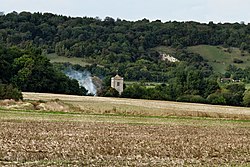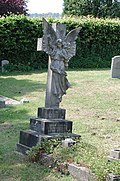| Church of St Peter and St Paul, Trottiscliffe | |
|---|---|
| Trottiscliffe Parish Church | |
 | |
 | |
| 51°19′13″N0°21′40″E / 51.3202°N 0.361221°E | |
| OS grid reference | TQ6463660538 |
| Location | Church Lane, Trottiscliffe, Kent ME19 [1] |
| Country | England |
| Language | English |
| Denomination | Church of England [2] |
| Previous denomination | Roman Catholicism |
| Website | Official website |
| History | |
| Status | Parish church |
| Founded | c.1080 |
| Dedication | Saint Peter and Saint Paul |
| Architecture | |
| Functional status | Active |
| Heritage designation | UK Grade I |
| Architectural type | Church |
| Style | Norman |
| Years built | c. 1080 |
| Groundbreaking | c. 1080 |
| Completed | c. 1200 |
| Specifications | |
| Floor area | 217 m2 (2,340 sq ft) |
| Number of towers | 1 |
| Number of spires | 1 |
| Materials | flint, ironstone, Kentish ragstone, tufa, [3] |
| Administration | |
| Province | Canterbury |
| Diocese | Rochester [4] [5] |
| Archdeaconry | Tonbridge [4] [5] |
| Deanery | Malling [4] [5] |
| Benefice | Birling: All Saints Addington: St Margaret Ryarsh: St Martin Trottiscliffe: St Peter and St Paul [4] [6] |
| Parish | Trottiscliffe [4] [5] |
| Clergy | |
| Rector | Interregnum [7] |
| Laity | |
| Churchwarden | Ann Gillett [2] |
| Founded | c.1080 |
Listed Building – Grade I | |
| Official name | Church of St Peter and St Paul [8] |
| Type | Listed building [8] |
| Designated | 25 August 1959 [8] |
| Reference no. | 1236191 [8] |
The Church of St Peter and St Paul is an active Anglican parish church in Church Lane, Trottiscliffe, in the Borough of Tonbridge and Malling, Kent, England. [9] It is situated below the North Downs on the lowest levels of the Lower Chalk, above a spring on the Gault clay top at approximately 280 feet above ordnance datum. [10]
Contents
- History
- High Middle Ages
- Late Middle Ages
- 18th and 19th centuries
- Post-war
- Present day
- Description
- Exterior
- Interior
- Churchyard
- See also
- References
- External links
The church dates from the late 11th century and is dedicated to saints Peter and Paul. It is a Pilgrim Church as it is located near to the Pilgrims' Way, the historical route purportedly taken by pilgrims from Winchester in Hampshire, to the shrine of Thomas Becket at Canterbury in Kent.
The church has been recorded in the National Heritage List for England as a designated Grade I listed building since 1959 [8] and is also notable for its large pulpit, which stood in Westminster Abbey until 1820. [11]









